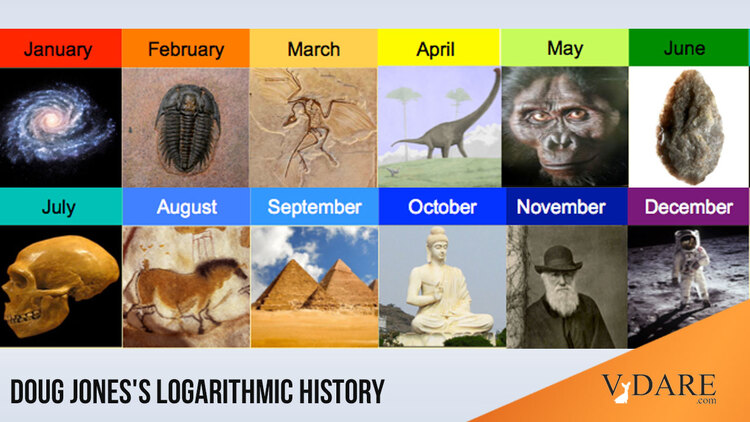
By Steve Sailer
12/15/2023
University of Utah anthropologist Doug Jones has a brilliant shtick on Twitter, Substack, and WordPress that he calls:
The history of the universe — from the Big Bang to the end of the year — day by day
The idea is that he starts with the Big Bang 13.8 billion years ago and writes about progressively shorter periods of time in each installment. While the first second or whatever of the Big Bang was exciting, things then slowed down for the next several hundred million years. Doug explains:
Compressing the history of the universe into one year is not a new idea: both Carl Sagan and Neil de Grasse Tyson did it. What’s different about the version here? The earlier work uses a linear scale, dividing the age of the universe by the number of days in a year, so that every calendar day covers a constant 37.8 million years in the history of the universe. This is useful for dramatizing just how long “billions and billions” of years really is. But it means that most of the events that people are most interested in — including all of the evolution of biological and cultural complexity — happen late in the year. The Earth forms in early September. Dinosaurs go extinct on December 30, and all of human evolution and human history happen [sic] late on December 31.
At Logarithmic History, by contrast, I use a logarithmic scale. Other folks have proposed putting the history of the universe on a logarithmic scale; here I map that scale onto the course of one year. If you’re a bit hazy about logarithms, all you have to know is that each day of the year covers a shorter period in the history of the universe than the preceding day (5.46% shorter). January 1 begins with the Big Bang and covers a full 754 million years. January 2 covers the next 712 million years, and so on. Succeeding days cover shorter and shorter succeeding intervals in the history of the universe. At this rate, a given calendar date covers only a tenth as much time as a date 41 days earlier.
On this logarithmic scale, Earth is formed on January 20, trilobites arise toward the end of February, and dinosaurs meet their doom on April 6. The middle of the year finds Homo erectus giving way to early versions of Neanderthals and Homo sapiens. October begins with King David and ends with Columbus. By December 7, we reach the year of the Beatles’ first LP (1963). December 31 covers just one year, 2017; calendar time and history-of-the-universe time finally coincide at midnight.
Of course, the gimmick succeeds only because he has great insights about each successive epoch. For example, by the middle of December, he’s up to the Rwandan genocide of 1994:
The internal violence in Rwanda was closely linked to external conflict. Next door to Rwanda is Burundi, with a similar demography — a Tutsi minority and a Hutu majority. But politics took a different course in the two countries. In Rwanda the Hutu took power when the country attained its independence in 1963, and the government directed massacres of Tutsi. Meanwhile, in independent Burundi, the Tutsi dominated. In 1972 100,000 Hutu were massacred there, while the next year saw anti-Tutsi riots in Rwanda. The genocide in 1994 followed a seizure of power by Hutu extremists, who played on fears of a Tutsi takeover. French political scientist Jacques Semelin calls Rwanda and Burundi “ethnic false twins.” He notes similar “fratricidal duos” in the case of other twentieth century genocides — Serbia and Croatia, Nazi Germany and the Soviet Union, Ottoman Turkey and Czarist Russia. In each case, mass killing of ethnic minorities — of Croats, Jews, Armenians — was tied, in the minds of the perpetrators at least, to life-and-death external threats.
The history of the Tutsi and the Hutu goes back a ways, although group boundaries were accentuated by Belgian colonial policy. Genetic and ethnohistoric evidence points to the Tutsi being an offshoot of the great migration of Nilotic cattle-herders over the last millennium (which shows some parallels with the earlier migrations of Indo-European speakers). Meanwhile the Hutu derive ultimately from an even greater demic expansion, of the Bantu. The Tutsi came to speak the same language as the Hutu, and there has been some intermarriage between the two populations, but they are still physically fairly distinct from one another, with the Tutsi taller and thinner. These physical differences played into the development of ethnic animosity, an instance of “somatic prejudice.” (I write about somatic prejudice — my coinage — here and in the last chapter of this book.)
A big theme of anti-Tutsi propaganda in the period leading up to the genocide is that Tutsi women were especially sexually alluring, but also wanton, dangerous, and emasculating. A few story titles, “Beautiful Tutsi Women as Bait into Servitude” and “The Death Trap of Tutsi Women’s Beauty,” make the point (as did a lot of visual pornography). In the Hutu Ten Commandments, a major piece of anti-Tutsi propaganda published in 1990, the first three commandments are concerned with getting Hutu men to resist the allure of Tutsi women.
This is a content archive of VDARE.com, which Letitia James forced off of the Internet using lawfare.